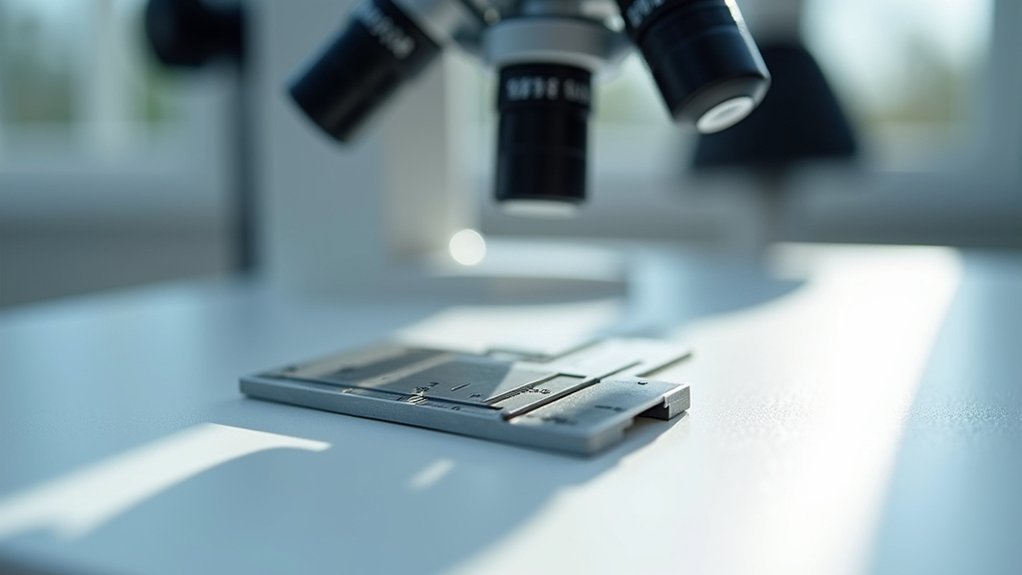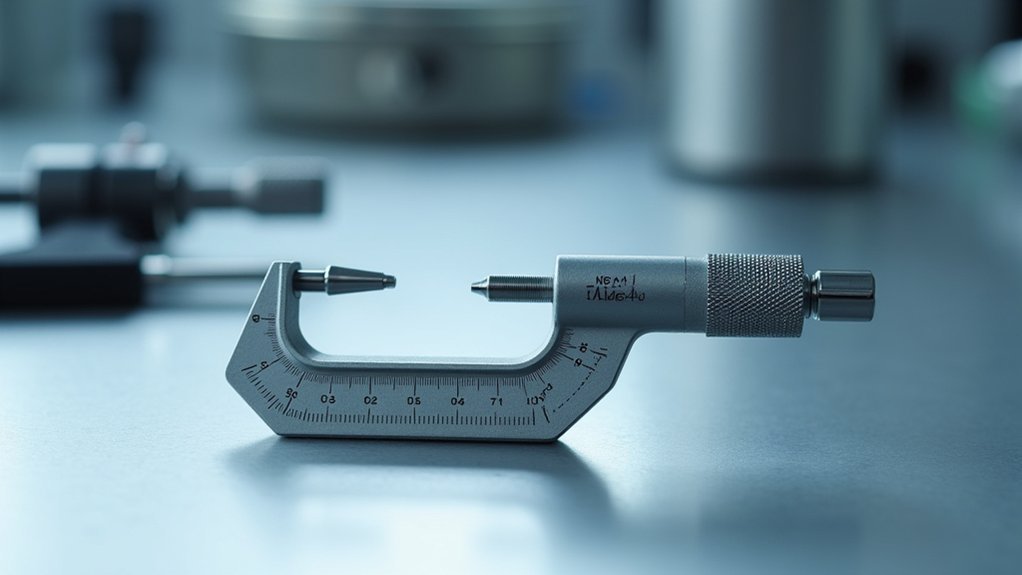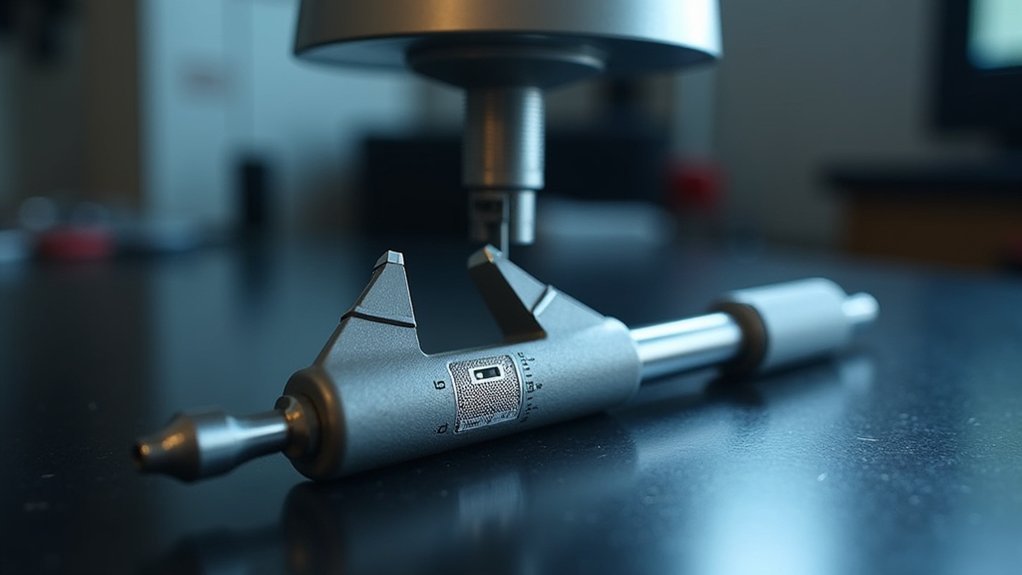For perfect scale measurements with a stage micrometer, make certain it’s clean, level, and secured on your microscope stage. Align the eyepiece graticule’s zero point with the micrometer scale and focus carefully. Take multiple readings at each magnification and convert units correctly. Maintain consistent lighting to prevent distortion, and recalibrate whenever changing objectives. Regular calibration checks will prevent drift over time. Discover how these simple techniques can transform your microscopic measurement accuracy.
Second-level Headings for “Simple Stage Micrometer Tips For Perfect Scale Measurements”

When structuring your guide on stage micrometer techniques, you’ll need clear organizational headings that address each critical aspect of the calibration process.
Consider these effective section headings for your article:
Structured headings create a logical pathway through complex calibration procedures, guiding readers from preparation to practical measurement conversion.
“Preparing Your Microscope Stage Micrometer for Calibration”
“Aligning Graticule and Stage Scales for Precision”
“Counting Divisions: Techniques to Avoid Errors”
“Multiple Measurements for Enhanced Accuracy”
“Converting Graticule Units to Actual Measurement Scale”
Each heading targets a specific calibration step while incorporating best practices.
Under “Preparing Your Microscope Stage Micrometer,” highlight cleaning procedures to prevent inaccuracies.
In “Counting Divisions,” offer techniques to accurately count scale markings.
Your “Converting Graticule Units” section should remind readers that standard divisions typically equal 10 microns, simplifying the calibration math and ensuring readers can confidently transform abstract divisions into practical measurements.
Understanding Stage Micrometers and Their Importance
Stage micrometers serve as your essential reference tools for converting arbitrary eyepiece measurements into actual dimensions with their precisely etched 0.01mm divisions.
You’ll need to understand the fundamental principles of precision measurement, including proper alignment between your stage micrometer and eyepiece graticule at each magnification level.
While you might think your microscope provides accurate readings automatically, regular calibration with a stage micrometer guarantees your measurements remain scientifically valid and reproducible across different specimens.
What Are Stage Micrometers
Precision tools form the backbone of accurate microscopy, and stage micrometers stand at the forefront of this precision. These specialized glass slides feature a carefully calibrated scale, typically with divisions of 0.01mm, that serves as your reference standard.
When you calibrate your eyepiece graticule, you’re aligning its arbitrary units with the known measurements on the stage micrometer’s scale. This calibration guarantees all subsequent measurements reflect actual physical dimensions.
| Micrometer Type | Scale Length | Typical Division | Primary Use |
|---|---|---|---|
| Standard | 1mm | 0.01mm | General microscopy |
| High-precision | 2mm | 0.005mm | Research applications |
| Specialized | 0.5mm | 0.001mm | Ultra-fine measurements |
| Cross-pattern | 1mm × 1mm | 0.01mm grid | Area measurements |
Remember that divisions on the scale represent known distances, allowing accurate measurement at any magnification.
Precision Measurement Principles
The foundation of reliable microscopy lies in understanding how accurate measurements are obtained and verified. When you’re working with microscopic specimens, your stage micrometer serves as the gold standard reference tool with its precisely etched 0.01 mm divisions.
For consistent results, you’ll need to calibrate your eyepiece graticule against the stage micrometer at each magnification level. Remember that each objective lens requires its own calibration, as magnification differences greatly affect graticule division values.
Don’t overlook regular calibration checks to prevent measurement errors that can arise from optical imperfections or procedural inconsistencies. This calibration process isn’t optional—it’s essential when you need to quantify specimen dimensions accurately in fields ranging from biological research to materials analysis.
Your measurements are only as reliable as your calibration protocol.
Calibration vs. Accuracy
While many researchers confuse calibration with inherent accuracy, they’re distinct concepts that work together to secure reliable microscopic measurements.
Calibration is the process of establishing the relationship between your eyepiece graticule and the stage micrometer’s precise 0.01mm markings. Accuracy, however, depends on how correctly you perform this calibration.
Remember, you’ll need to calibrate each objective lens separately since magnification changes alter graticule division values. Even with perfect calibration procedures, optical defects, misalignment, and human error can compromise accuracy.
To guarantee trustworthy results, regularly verify your calibration against known standards. This verification step isn’t excessive—it’s essential.
Without it, seemingly minor discrepancies can propagate into significant measurement errors that undermine your entire analysis.
Essential Tools for Accurate Calibration
Three key instruments form the backbone of proper microscope calibration: the stage micrometer, eyepiece graticule, and measurement software.
You’ll need these tools to establish reliable reference points and guarantee consistent measurements across different magnification factors.
- Stage micrometer – Features precise 0.01mm markings that serve as your calibration reference standard.
- Eyepiece graticule – Must be aligned with the stage micrometer’s zero point for accurate calibration.
- Calibration software – Programs like Motic or Meazure enhance precision when maintained at 100% zoom.
- Objective lenses – Each requires independent calibration due to their unique magnification factors.
Remember to place your stage micrometer directly under the objective lens and focus carefully.
This systematic approach guarantees your measurements remain consistent and reliable regardless of which objective you’re using.
Step-by-Step Calibration Technique

Now that you’ve gathered your calibration tools, let’s walk through the precise steps for calibrating your microscope. Place your stage micrometer on the stage and center it under your objective lens. Focus carefully, then align the eyepiece graticule with the micrometer scale, matching their zero points.
| Magnification | Action | Calculation | Result | Purpose |
|---|---|---|---|---|
| 4x | Count divisions | 1000µm ÷ divisions | µm per division | Low power baseline |
| 10x | Repeat alignment | 1000µm ÷ divisions | µm per division | Standard viewing |
| 40x | Align precisely | 1000µm ÷ divisions | µm per division | Detailed work |
| 100x | Use oil immersion | 1000µm ÷ divisions | µm per division | High resolution |
| All objectives | Record values | Create reference chart | Quick reference | Consistent results |
Always calibrate each objective separately, as measurements will vary with magnification. Once properly calibrated, your eyepiece graticule will provide accurate measurements across all specimens.
Common Calibration Errors and How to Avoid Them
You’ll face significant measurement errors if your stage micrometer and eyepiece graticule aren’t perfectly aligned during calibration.
When switching between objective lenses, you must recalibrate each time to account for magnification drift that alters the scaling relationship.
Your focus technique matters too—improper focusing creates parallax issues that can skew measurements and compromise your microscopy results.
Parallax Alignment Issues
When calibrating your stage micrometer, one of the most common errors stems from parallax misalignment—a deceptively simple problem that can greatly impact measurement accuracy.
To guarantee precise measurements, you’ll need to eliminate these alignment issues between your eyepiece graticule and stage micrometer.
Follow these steps to minimize parallax errors:
- Focus on the stage micrometer first, then adjust your eyepiece graticule to match it perfectly.
- View both scales from directly above, maintaining a straight line of sight.
- Position both the stage micrometer and eyepiece graticule in the same plane to eliminate angle distortions.
- Use the fine-tuning adjustment on your microscope stage to guarantee both scales are viewed clearly and simultaneously.
Remember to calibrate regularly at each magnification you’ll be using for your measurements.
Magnification Drift Corrections
Magnification drift represents another common challenge that can undermine your calibration efforts even after you’ve solved any parallax issues. When your micrometer scale is superimposed on the specimen, even slight movements can distort measurements considerably. It’s important to calibrate regularly, especially when switching objectives.
| Factor | Effect | Solution |
|---|---|---|
| Movement | Scale misalignment | Stabilize microscope setup |
| Optical elements | Image distortion | Clean lenses thoroughly |
| Lighting changes | Size perception variations | Maintain consistent illumination |
To combat magnification drift effectively, verify your stage micrometer is properly centered before calibration. Use the same lighting and focus settings throughout your measurement session. Remember that different objectives experience varying degrees of drift over time, so perform calibration checks at your working magnification before each critical measurement series.
Choosing the Right Calibration Method for Your Magnification

Since accurate measurements depend entirely on proper calibration, selecting the appropriate method for your specific magnification is essential.
When working with different objective lenses, you’ll need to determine how your eyepiece graticule divisions translate to actual micrometers for each magnification.
- With a 10X objective, each graticule division typically equals 10 micrometers, but you should still verify this using your stage micrometer.
- For 40X objectives, count the number of graticule divisions that align with known micrometer scales to calculate your exact calibration ratio.
- Always calibrate each objective lens separately to maintain measurement consistency across magnifications.
- Choose straight line calibration methods over circular ones, especially if calibration circles appear elliptical, as this improves accuracy across all divisions.
Remember to recalibrate regularly when switching between specimen types or magnifications.
Frequently Asked Questions
How to Calibrate Using Stage Micrometer?
To calibrate using a stage micrometer, you’ll place it on the microscope, align with the eyepiece graticule, count divisions against known measurements, calculate the value per division, and repeat for each objective.
How to Measure Objects With a Stage Micrometer?
To measure objects with a stage micrometer, you’ll first calibrate your eyepiece graticule, then replace the micrometer with your specimen and count how many graticule divisions it spans, multiplying by your calibration value.
How to Work Out Epu?
To work out EPU, align your stage micrometer with eyepiece graticule, count graticule divisions matching a known micrometer distance, then divide the actual micrometers by graticule divisions. Remember to maintain consistent magnification for accurate results.
How Much Is One Division on a Stage Micrometer?
One division on a stage micrometer is typically 0.01mm or 10 microns. You’ll find that larger divisions usually represent 0.1mm (100 microns), which you’ll use when calibrating your eyepiece graticule for accurate measurements.
In Summary
You’re now equipped to achieve perfect scale measurements with your stage micrometer. Don’t forget to calibrate regularly, use the right tools for your magnification, and avoid common errors like improper focusing. With these simple tips, you’ll capture accurate measurements every time. Remember, precision isn’t complex—it’s about consistent technique and proper calibration. Your microscopy work will thank you for the attention to detail.





Leave a Reply